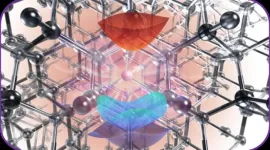(Press-News.org) COLUMBUS, Ohio – A lot has changed in the world since the Endangered Species Act (ESA) was enacted 50 years ago in December 1973.
Two researchers at The Ohio State University were among a group of experts invited by the journal Science to discuss how the ESA has evolved and what its future might hold.
Tanya Berger-Wolf, faculty director of Ohio State’s Translational Data Analytics Institute, led a group that wrote on “Sustainable, trustworthy, human-technology partnership.” Amy Ando, professor and chair of the university’s Department of Agricultural, Environmental, and Development Economics, wrote on “Harnessing economics for effective implementation.”
Berger-Wolf and her colleagues wrote, “We are in the middle of a mass extinction without even knowing all that we are losing and how fast.” But technology can help address that.
For example, they note the value of tools like camera traps that survey animal species and smartphone apps that allow citizen scientists to count insects, identify bird songs and report plant observations.
New tech has allowed scientists to monitor animal and plant populations at scale for the first time, said Berger-Wolf, who is also a professor of computer science and engineering, evolution, ecology and organismal biology, and electrical and computer engineering. One challenge is to find new ways to extract all the information from these new sources of data.
“But even with all this data, we are still monitoring only a tiny fraction of the biodiversity out in the world,” she said. “Without that information, we don’t know what we have, how different species are doing and whether our policies to protect endangered species are working.”
Most important, Berger-Wolf said, is the need to make sure to keep humans in the process. Technology needs to connect data, connect different regions of the world, connect people to nature and connect people to people.
“We don’t want to sever the connection between people and nature, we want to strengthen it,” she said.
“We cannot rely on technology to save the world’s biodiversity. It has to be an intentional partnership between humans and technology and AI.”
Economics should be another partner in the fight to save endangered species, Ando said.
“There’s this tendency to think that protecting endangered species is all about biology and ecology,” Ando said. “But various tools in economics are very helpful in making sure the work we do to implement the Endangered Species Act is successful. That is not always obvious to people.”
For example, bioeconomic research is a multidisciplinary effort between economists and biologists to work together to see how human behavior interacts with ecological processes and systems.
“We have to take into account feedback effects. People take an action, and that changes the ecosystem and that changes what people do,” she said. “We need to capture those feedback effects.”
The result can be novel ways to protect endangered species, such as “pop-up” habitat modification. For example, ranchers can take down fences temporarily while elk are migrating to allow them to move freely. Rice fields can be temporarily flooded during shorebird migration to give them a place to rest and feed on their travels.
We can “draw upon economics to optimize the timing, location and extent of temporary actions to maximize their net benefits to society,” Ando wrote in Science.
Another way economics can help is to develop policies that protect species before they become so threatened that they need ESA protection.
A common issue is that multiple landowners will all need to work together to protect the habitat of threatened species. But often, if some landowners take actions to protect a species, other landowners will think they don’t have to.
“Economists have been working to understand how we can coordinate landowners where we don’t have to implement draconian land use regulations, but still protect habitat,” Ando said.
“That is a very promising tactic that can protect species and also reduce the cost to people of doing so.”
END
How technology and economics can help save endangered species
Experts look at future of Endangered Species Act
2023-12-21
ELSE PRESS RELEASES FROM THIS DATE:
Sniffing women’s tears reduces aggressive behavior in men
2023-12-21
New research, publishing December 21st in the open access journal in PLOS Biology, shows that tears from women contain chemicals that block aggression in men. The study led by Shani Agron at the Weizmann Institute of Science, Israel, finds that sniffing tears leads to reduced brain activity related to aggression, which results is less aggressive behavior.
Male aggression in rodents is known to be blocked when they smell female tears. This is an example of social chemosignaling, a process that is common in animals but less common—or less understood—in humans. To determine whether tears have the same affect in people, ...
Polar bear fur-inspired fibers offer exceptional thermal insulation, tested in a sweater
2023-12-21
Inspired by the structure of polar bear fur, researchers present a knittable aerogel fiber with exceptional thermal and mechanical properties. The fibers are washable, dyeable, durable, and well-suited to be used in advanced textiles. This allowed the researchers to test them in a sweater that demonstrated impressive thermal insulation, among other features. Aerogels are an ideal material for thermal insulation. They demonstrate high porosity and extremely low thermal conductivity. However, the application of ...
Racial disparities in health motivate more support for social action than other racial disparities
2023-12-21
Racial disparities related to health and physical well-being motivate Americans to take action for social change more than racial disparities related to other factors, like economics, a new study finds. This is because health-related racial inequalities are perceived to be more unjust. The results suggest that framing racial disparities to tap into feelings of moral injustice may motivate policy reform – a finding of potential interest to policymakers, social movements, and citizens seeking to gain support for actions to reduce racial inequality. “…this work can help us understand ...
Octopus DNA reveals West Antarctic Ice Sheet collapse during Last Interglacial
2023-12-21
Genetic analyses of an Antarctic octopus show that the West Antarctic Ice Sheet (WAIS) collapsed during the Last Interglacial ~129,000 to 116,000 years ago when temperatures were only about 1 degree Celsius (°C) warmer than preindustrial levels. The findings suggest that WAIS collapse and resultant sea-level rise could be caused by even the minimal temperature rises projected by the most optimistic climate change mitigation plans. Climate change is driving unprecedented change to Earth’s cryosphere. The West Antarctic Ice Sheet is considered particularly vulnerable to warming ...
Can cryptocurrencies be legal tender? A case study from El Salvador
2023-12-21
In El Salvador, preference for cash and privacy fears deterred the widespread adoption of Bitcoin as an everyday currency, researchers report. The findings suggest that policies incentivizing cryptocurrency adoption as legal tender will likely fail unless populations are financially literate and already trust digital currencies. The introduction of digital currencies is one of the most important developments in monetary economics in the last decade. Unlike traditional digital currencies, which rely on central authorities such as governments or banks governed by regulations ...
Researchers map how measles virus spreads in human brain
2023-12-21
ROCHESTER, Minn. — Mayo Clinic researchers mapped how the measles virus mutated and spread in the brain of a person who succumbed to a rare, lethal brain disease. New cases of this disease, which is a complication of the measles virus, may occur as measles reemerges among the unvaccinated, say researchers.
Using the latest tools in genetic sequencing, researchers at Mayo Clinic reconstructed how a collective of viral genomes colonized a human brain. The virus acquired distinct mutations that drove the spread of the virus from the frontal cortex outward.
"Our study provides compelling data that ...
Organic compounds in asteroids formed in colder regions of space: study
2023-12-21
Analysis of organic compounds – called polycyclic aromatic hydrocarbons (PAHs) – extracted from the Ryugu asteroid and Murchison meteorite has found that certain PAHs likely formed in the cold areas of space between stars rather than in hot regions near stars as was previously thought. The findings open new possibilities for studying life beyond Earth and the chemistry of objects in space.
The only Australian members of an international research team, scientists from Curtin’s WA-Organic ...
Advanced computational tool for understanding quantum materials
2023-12-21
Researchers at the University of Chicago’s Pritzker School of Molecular Engineering (PME), Argonne National Laboratory, and the University of Modena and Reggio Emilia have developed a new computational tool to describe how the atoms within quantum materials behave when they absorb and emit light. The tool will be released as part of the open-source software package WEST, developed within the Midwest Integrated Center for Computational Materials (MICCoM) by a team led by Prof. Marco ...
Role of enzyme SMYD3 clarified in prostate cancer progression
2023-12-21
Prostate cancer is the most common cancer in men other than skin cancer, and more than 288,000 new cases are diagnosed every year, according to the American Cancer Society. The disease’s fatality rate has decreased by more than half since the 1990s, but there is still room for progress—especially in treating or preventing advanced, metastatic disease, which is much more likely to be fatal.
A new paper published in Science Advances clarifies how an enzyme called SMYD3 may be involved in prostate ...
Professor Vladimir A. Botchkarev, Boston University School of Medicine, receives Skin Ageing & Challenges Best Scientific Award 2023
2023-12-21
The Skin Ageing & Challenges 2023 conference, held in November 2023 in Lisbon, has recognized the outstanding contributions of Prof. Vladimir A. Botchkarev, a distinguished Professor of Dermatology and Co-Director at the Boston University Center for Aging Research, with the prestigious Skin Ageing & Challenges Best Scientific Award 2023. The award acknowledges Prof. Botchkarev's exceptional research in the field of skin biology and aging.
Prof. Botchkarev's award-winning work, titled "Skin Aging in Long-Lived Naked Mole-Rats: Mechanisms and Perspectives", delves into the complicated aging process of Naked Mole Rats' skin. His comprehensive ...
LAST 30 PRESS RELEASES:
Eye for trouble: Automated counting for chromosome issues under the microscope
The vast majority of US rivers lack any protections from human activities, new research finds
Ultrasound-responsive in situ antigen "nanocatchers" open a new paradigm for personalized tumor immunotherapy
Environmental “superbugs” in our rivers and soils: new one health review warns of growing antimicrobial resistance crisis
Triple threat in greenhouse farming: how heavy metals, microplastics, and antibiotic resistance genes unite to challenge sustainable food production
Earthworms turn manure into a powerful tool against antibiotic resistance
AI turns water into an early warning network for hidden biological pollutants
Hidden hotspots on “green” plastics: biodegradable and conventional plastics shape very different antibiotic resistance risks in river microbiomes
Engineered biochar enzyme system clears toxic phenolic acids and restores pepper seed germination in continuous cropping soils
Retail therapy fail? Online shopping linked to stress, says study
How well-meaning allies can increase stress for marginalized people
Commercially viable biomanufacturing: designer yeast turns sugar into lucrative chemical 3-HP
Control valve discovered in gut’s plumbing system
George Mason University leads phase 2 clinical trial for pill to help maintain weight loss after GLP-1s
Hop to it: research from Shedd Aquarium tracks conch movement to set new conservation guidance
Weight loss drugs and bariatric surgery improve the body’s fat ‘balance:’ study
The Age of Fishes began with mass death
TB harnesses part of immune defense system to cause infection
Important new source of oxidation in the atmosphere found
A tug-of-war explains a decades-old question about how bacteria swim
Strengthened immune defense against cancer
Engineering the development of the pancreas
The Journal of Nuclear Medicine ahead-of-print tip sheet: Jan. 9, 2026
Mount Sinai researchers help create largest immune cell atlas of bone marrow in multiple myeloma patients
Why it is so hard to get started on an unpleasant task: Scientists identify a “motivation brake”
Body composition changes after bariatric surgery or treatment with GLP-1 receptor agonists
Targeted regulation of abortion providers laws and pregnancies conceived through fertility treatment
Press registration is now open for the 2026 ACMG Annual Clinical Genetics Meeting
Understanding sex-based differences and the role of bone morphogenetic protein signaling in Alzheimer’s disease
Breakthrough in thin-film electrolytes pushes solid oxide fuel cells forward
[Press-News.org] How technology and economics can help save endangered speciesExperts look at future of Endangered Species Act


